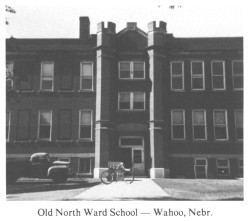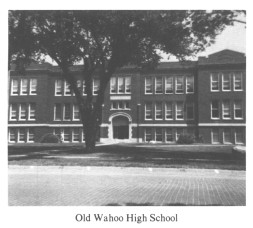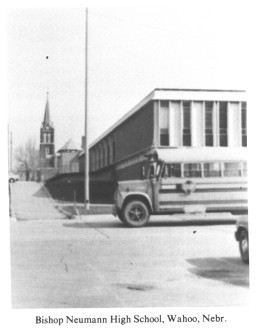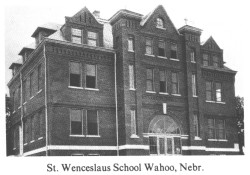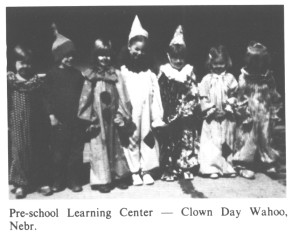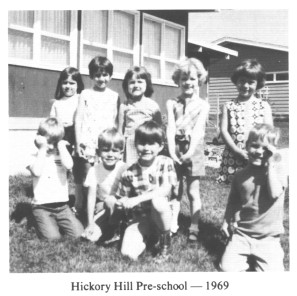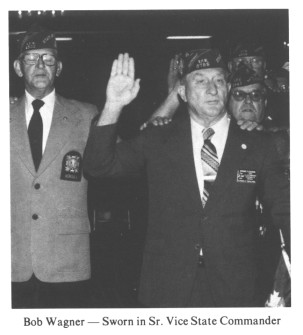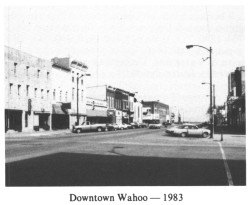 |
STOCKING PRECINCT |
|
of service to the community. However, most of all, efforts are made to try and prepare the students for happy and useful lives. It is the hope of the administration and staff that Neumann High will continue to work toward the goal of Christian education of the total person so clearly exemplified in the life of its patron, Bishop John Neumann.
ST. WENCESLAUS SCHOOLSt. Wenceslaus School has served the community of Wahoo for over 70 years. Records, dated back to 1910, indicate that it was staffed by the Benedictine Sisters for 13 years. During the early years it encompassed grades one through ten. The Sisters lived in the school and the students were allowed to board there. In 1923, the Notre Dame Sisters from Omaha agreed to teach at St. Wenceslaus and have served us faithfully ever since. The first Marian Sisters came in 1967 and the first lay teacher began in 1956. The first lay principal was employed in 1973. Through the years the enrollment has gone from 91 students in 1933 to 298 in 1963 when it was a K-12 school. St. Wenceslaus School now contains grades K-8. Grades K-6 are self-contained while the Junior High is departmentalized. The Religion Department at St. Wenceslaus has continued to be active through the years. Students plan their daily Masses. All grades strive to bring Christian enjoyment to the people of the community. The students entertain at the Care Centers, visit the elderly, care for the young and a variety of other activities. 1957 marked the year Jr. High sports were introduced at St. Wenceslaus. At the time only boys football and basketball were offered. Today, both boys and girls are offered a variety of athletic programs. Band has been a part of the curriculum since the first group was formed in 1958. Vocal music has recently been added to the program. The first musical took place in 1983. Presently, St. Wenceslaus School employs 2 Marian Sisters, 4 Notre Dame Sisters, and 6 lay faculty. Present enrollment for grade K-8 is 180 students. St. Wenceslaus School now serves the local Catholic parish and several surrounding parishes in its attempts to offer more children the alternative of a Catholic, God-centered education.
PRE-SCHOOL LEARNING CENTERThe pre-school Learning Center opened in the fall of 1975 at the home of Mrs. Mike McDonald. Classes were held from 9-ll o'clock on Monday, Wednesday, and Friday mornings and from 1-3 p.m. each Monday, Wednesday, and Friday afternoons, plus a Tuesday-Thursday morning session from 9-11 a.m. A total of 24 youngsters were involved in a total program. The learning center was open for a total of 5 years. Maurene Johnston assisted with the programs on various outings and projects. Two pre-schools operating in Wahoo for 1982-83 are headed by: Mrs. Kevin (Judy) Stukenholtz and Mrs. Paul (Jill) Johnson. HICKORY HILL PRE-SCHOOLThe first pre-school in Wahoo and Saunders County was opened in the fall of 1969 in the basement of the home of Jane Johnson (Mrs. Burton). Seeing a definite need for this type of education, Jane, ably assisted by Geeg Erickson (Mrs. E. Gerald), welcomed nine 4-year-olds to the Hickory Hill Pre-School, which met from 9-11 o'clock a.m. each Monday, Wednesday, and Friday mornings. The students who attended this pre-school that first year were Susan Wentz, Cathy Hohl, Natalie Fox, Karla Christensen, Melissa Olander, Mark Sutton, Stuart Oden, John Hansen, and David Detlefson. A few years later, Pat Bennett and Mary Likes opened a pre-school in the home of Mary Likes. Kay Ferguson opened a pre-school at the National Guard Armory in 1974.
WAHOO BURLINGTON DEPOTWahoo, unlike must other Saunders County towns, was served by not one, but three railroads in the late 1890's and early 1900's. The Union Pacific, the Northwestern, and the Chicago, Burlington, & Quincy each maintained a depot to serve the community. Today only the Burlington depot remains. It was saved from destruction by citizens who wished to retain a visible link with the past. The depot has become a part of the Saunders County Historical Complex and has been restored at its original site. The building was constructed in 1886 and completed prior to the arrival of the trackage. It opened for business in early 1887 and closed its doors on June 22, 1972. The two-story frame structure has wooden floors, is 14 by 56 feet with an attached one-story freight house. The freight storage room is 24 by 34 feet and has plank floors. The total cost of the building was $3,475. There were two waiting rooms, a furnished agent's office with telegraph facilities, a small baggage room, and the freight room. The depot agent's family lived on the second floor. There are six rooms: two bedrooms, living room, dining room, kitchen with a pantry, and a small bathroom. There was also a small stockyard nearby that held the animals waiting to be shipped by rail. The construction of the tracks began at Ashland and the 18.93 miles to Wahoo was completed April 5, 1887. The rails continued on to Schuyler for another 31.10 miles and the track was ready for operation on October 24, 1887. Early records are not obtainable, but O.P. Lowery was depot agent in 1893; John Boumann in 1902; John Hohl, 1903-1907; Iva Edwards, 1907-1919; Joe Bowers, 1919-1953; Ed Steinbaugh, relief agent; Anton Swanda, 1953-1962; and Clark Butcher, 1962-1972. Longevity honors must go to Joe Bowers who served as Burlington agent for 34 years. It was his gift of his later home and the area surrounding it that helped make the Saunders County Historical Complex a reality. The role the railroads played in the development of the nation can not be understated for those first stations many times formed the nucleus of the town. Without a station to serve them, many towns would have disappeared; with a station many towns, like Wahoo grew into prosperous communities. In the early 1900's this railroad spur line from Ashland to Schuyler was the most productive fifty miles track on the Burlington system. Small railroad depots that once were an integral part of every town are fast disappearing. But the Burlington Depot in Wahoo gives testimony to the colorful age they represented.
page 143 |
| Back | Contents | Next |
The Saunders County NEGenWeb Project
